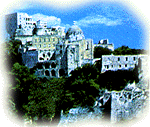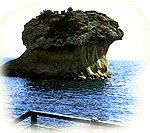 |

|
|
A LITTLE HISTORY |
|
Recent studies have shown that the island of Ischia has been inhabited since pre-historic times. Flint and volcanic glass instruments dating from 300BC have been found in many inland areas, along with Bronze and Iron Age ceramic fragments. Due to underwater volcanic activity, Ischia emerged from the sea, one night, in an era unknown even to geologists.The first clod to emerge was the peak of Mount Epomeo, further eruptions causing the other "mountains". Today, fortunately, volcanic activity on the island is limited to the presence of its thermal waters and numerous steam geysers with temperatures that can reach 106 degrees centigrade. In the area of San Michele fragments of vases concealed under volcanic ash, belonging to the Neolithic age have been uncovered, thus proving man's presence in this period. There is also evidence of Bronze and Iron age settlements. The Greeks were the first to settle in the Monte Vico area of Lacco Ameno naming the island "Pithekoussai", its position being ideal for their commercial trade in the eastern Mediterranean. Later the Romans changed its name to "Aenaria" and appreciating greatly the benefits of its spring and thermals waters, erected many temples particularly at Nitrodi in Barano. After the fall of the Roman Empire Ischia was invaded by various Barbarian tribes. The Island was first called "Insula" as recorded in a letter sent from Pope Leone III to Carlo Magno in 813 altering throughout the ages to Insla, Isla, Iscla and finally Ischia. With the end of the Ducy of Naples the island passed under the dominion of the Normans, Swedish, Agevin and Aragons. Following the eruption of Mount Trippodi in 1301 its inhabitants fled to the mainland and four years later ventured back to the Castle. In 1320 Robert of Angevin visited the Castle, accompanied by his wife Sancia di Majorca. With the new dynasty started by Alfonso I of Aragon, the Castle became a fortified and unconquerable city. Ferdinando II (Ferrandino) escaped from the city of Naples which was occupied by Charles VIII's troops and took refuge in the Castle. After assassinating the traitor/Lord of the Manor, Giustino della Candida, Ferdinando II left the Castle in the hands of Innico d'Avalos Marquis of Pescara and Vasto, who valiantly defended it against the attacking French fleet. The Castle and island passed under the control of the D'Avalos family until the middle of the XVIII century. The poetess Vittoria Colonna married Ferrante D'Avalos, victor of the Battle of Pavia in the Castle's Cathedral on 27th December 1509. Under her guidance and that of Costance D'Avalos the Castle became a literary circle of European fame. After a period of obscurity the island again found fame under the Bourbon Dynasty. Carlo III actuated a social recovery, abolishing the feudal regime of the D'Avalos' and suppressing the bands of brigands living in the hills of the island. With this first reform the island fell under Royal domain and was administrated and governed from the Castle. At the time of the Partenopen Republic many Ischitan intellectuals mainly priests, actively participated in the Jacobean movement. But in March 1799 the patriots' hopes were dashed in a blood bath. Francesco Buonocore nephew of Doctor Buonocore Commandor of Ischia was among the martyrs hung. Under the domain of Gioacchino Murat, the French occupied the island and defended it behind the Castle's battlements from the attacking English/Bourbon fleet led by Admiral Nelson. Ferdinando II of Bourbon enlarged the small lake in Ischia Port, officially opening it 17th September 1854, he also built the Church of Portosalvo and the inland road between Lacco Ameno and Forio. With the unity of Italy and an increasing interest in thermal waters a tourism of the "elite" began, initally in Casamicciola Terme, site of many important thermal establishments, among which the Pio Monte della Misericordia. | ||



